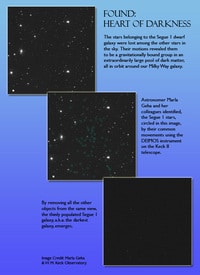By Tushna Commissariat
This week has seen its fair share of intriguing space stories, with colliding moons, Trojan asteroids, more evidence for water on Mars and even a hint of evidence for bubble universes. But a press release about another interesting find from the Keck telescope in Hawaii that was seemingly lost in all noise caught my eye – astronomers in the US have discovered a cluster of about 1000 small, dim stars just outside the Milky Way, comprising what is now the darkest known galaxy. The dwarf galaxy is also said to have a treasure trove of ancient stars, some of the oldest ever seen. Using the 10 m Keck II telescope in Hawaii, the astronomers have been gathering data about the galaxy now dubbed Segue 1.
Interestingly, when they call it the darkest galaxy, astronomers are not referring to how much light the galaxy puts out, but the fact that the dwarf galaxy appears to have 3400 times more mass than can be accounted for by its visible stars. In other words, Segue 1 is mostly an enormous cloud of dark matter decorated with a sprinkling of stars. The initial claim of it being the darkest galaxy was made two years ago by Marla Geha from Yale University and Joshua Simon from the Carnegie Institution of Washington, and their colleagues. Their claim was based on data from the Sloan Digital Sky Survey and the Keck II telescope.
Initial observations indicated that the stars were all moving together and were a diverse group, rather than simply a cluster of similar stars that had been ripped out of the nearby star-rich Sagittarius dwarf galaxy. Because some astronomers were doubtful of the results, Simon, Geha and their group returned to Keck and went to work with the telescope’s Deep Extragalactic Imaging Multi-Object Spectrograph (DEIMOS) to measure how the stars move not just in relation to the Milky Way, but also in relation to each other. A paper with the new findings was published in the May 2011 issue of the Astrophysical Journal.
If the 1000 or so stars were all there was to Segue 1, with just a smidgeon of dark matter, the stars would all move at about the same speed, said Simon. But that was not what they observed. Instead of moving at a steady 209 km/s relative to the Milky Way, some of the Segue 1 stars are moving at rates as slow as 194 km/s while others are going as fast as 224 km/s. The mass required to cause the different star velocities that were observed has been calculated at 600,000 solar masses. But, oddly enough, Segue 1 only has about 1000 stars and they are all close to the mass of the Sun.
The galaxy’s collection of primordial stars is also of interest to the astronomers, as previous searches for primitive stars among the Milky Way’s billions have yielded less than 30. The researchers gathered iron data on six stars in Segue 1 with the Keck II telescope, and a seventh Segue 1 star was measured by an Australian team using the Very Large Telescope. Of those seven, three proved to have less than one 2500th as much iron as our own Sun. “In Segue 1 we already have 10% of the total in the Milky Way,” Geha said. “For studying these most primitive stars, dwarf galaxies are going to be very important.”
Thanks to all the interesting results from Segue 1, other researchers have been looking at it with the space-based Fermi Gamma Ray Telescope. They hope to catch a glimpse of gamma rays, which are predicted by current theories to be the marker for dark matter – they could be created by the collision and annihilation of pairs of dark-matter particles. Unfortunately, the Fermi telescope hasn’t seen any tantalizing flares from Segue 1, but that doesn’t mean that the dark matter is not present, explains Simon. “The current predictions are that the Fermi telescope is just barely strong enough or perhaps not quite strong enough to see these gamma rays from Segue 1,” he said. “So there are hopes that Fermi will detect at least the hint of a collision.”
In the meantime, Simon says that he is working on a study of the seven red giants in Segue 1 that will measure the abundance of elements other than iron in their atmospheres to learn about what Segue 1 looked like at the time those stars formed. But this data relies on new observations. “We have recently obtained much deeper imaging of Segue 1 that we will be using to determine its structure and search for stars that may have been stripped from the galaxy by the tidal forces of the Milky Way,” he says. It will be interesting to see if this dark host has any more secrets to reveal.




